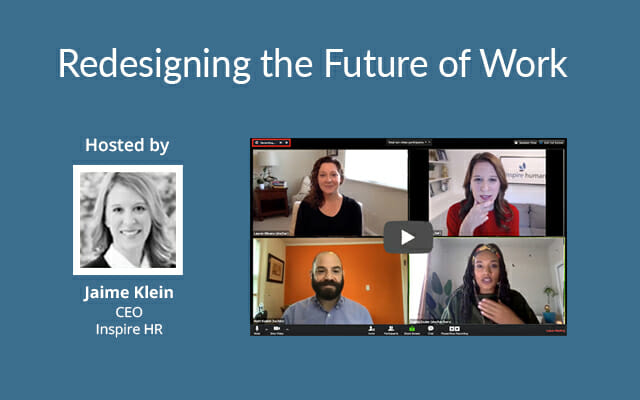
How to Improve Company Culture (10 Ways)
NOV 11, 2021
There is a lot of focus on the need to improve company culture in response to the racial reckoning following the murder of George Floyd, the “Great Resignation” impacting every HR leader I speak to these days, and the surge of employee burnout. The fact that all of these challenges exist at the same point in time only makes the need to improve company culture even greater.
According to a July 2021 survey by SHRM, 40% of employees feel burned out, drained, or exhausted from work, 30% of employees report struggling to get necessary work done, and 27% feel less loyal to their organization.
With all of the focus on improving company culture, and why it’s absolutely critical at this point in time, there is less talk about specifically how to improve company culture from the top-down and the ground-up. So, we’re getting straight to the tactics to help you address the pressing challenge: how to improve company culture.
Ten Ways to Improve Company Culture:
1. Evaluate your culture, set goals, and measure progress.
According to Heidrick & Struggles research, 82% of CEOs say culture is important but far fewer acknowledge culture’s impact on performance. It’s crucial to keep a finger on the pulse of employee engagement and sentiment through regular surveys, town halls, and one of my favorite retaining tactics: “stay” interviews. For example, at a minimum once per year, I conduct stay interviews where I ask each of our employees at Inspire:
- What do you love most and least about your role?
- What resources do you need to do your best work?
- What can I do more or less as your manager?
- Are there moments you felt friction when you considered leaving? If so, what caused you to stay?
Every company was forced to make sudden changes in March 2020, and if you haven’t recently, now is the time to take a moment and evaluate what’s working, what isn’t, and what’s missing in your company culture. Evaluate if your goals have shifted or need to be realigned to your values, then build metrics into managerial performance reviews, retention goals, and operational strategy.
2. Listen.

Early in the pandemic we were thrilled to help facilitate listening circles, to see organizations commit greater resources to their employee resource groups (ERGs), and to engage in open town halls. If you’ve relaxed these efforts, it’s time to revisit what you learned and to facilitate more open dialogue with your teams. Rose Gailey, Partner, Heidrick Consulting, Organization Acceleration & Culture Shaping at Heidrick & Struggles, and co-author of the recently released, Future Focused: Shape Your Culture. Shape Your Future shares that now, more than ever, leaders need to be empathetic and have “the ability to listen with understanding to secure psychological safety and provide a safe place for employees to voice concerns.” Tuning into other people’s experience will also enable leaders to engage employees, find clarity, and lead with purpose and intention.
3. Bring your whole self to work (set the example from the top).
Sophia Dozier, Diversity, Equity and Inclusion Leader at IBM shared a story with us on Redesigning the Future of Work that has stuck with me since. In the week following the murder of George Floyd, a Vice President invited her team to an impromptu sharing circle, where she took the lead in stating how tired and frustrated she felt. Whether it’s taking parental leave, using vacation time, maintaining a flexible schedule, admitting when you’re feeling overwhelmed, or otherwise prioritizing your well-being, employees will take this as permission to do the same.

4. Equip your leaders to manage a hybrid workforce.
As more employees work remotely, a manager is increasingly becoming more of a coach and less of a supervisor. And it will be an easier transition for some than others. Managers need training and guidance around how to engage teams that are split between remote and in-person, performance review systems fit for a more independent workforce, and their role in promoting employee wellness and company culture.
5. Communicate realistic employee expectations.

Pamela Sinclair, Corporate Vice President and Global Head of Human Resources at PGIM, the Global Investment Management Business of Prudential Financial, shared with us during “Strengthening Company Culture Through the Pandemic + Beyond” that a large source of friction between employees comes from a lack of clear expectations. She stresses the need for employees to share what they need—for example, a caregiver who cannot take meetings during school pickup times—and for employers to actively check-in and ask questions so their team feels comfortable sharing. Every person has been affected by the pandemic in a different way, but we’ve all been affected. It’s up to leaders to consistently communicate and ensure everyone on their team understands the expectations for their work and the resources available to assist them.
6. Establish (and enforce) remote meeting policies.
Zoom fatigue is a reality for everyone from entry-level to the C-suite. Create realistic and human-centric policies to regulate remote meetings. Several of our clients have instituted 50-minute and 25-minute frameworks to give people a chance to breathe in between meetings, others have blackout times, for example Wednesday and Friday afternoons, designated as meeting-free times. Also be clear about when to have cameras on, which meetings will include open check-ins, and other ways to set reliable expectations for employees.
7. Provide opportunities for employees to create friendships.
People with close work friends are 96% more likely to feel “extremely satisfied with life,” according to Tom Rath, author of Vital Friends: The People You Can’t Afford to Live Without. But according to Gallup, just 15% of remote workers report that they have a best friend at work. It is particularly important for leaders of a remote or hybrid workforce to create opportunities for employees to socialize, to carve out time for employees to share and bond over travel experiences, families, and even music tastes—creating human connections. Post a fun poll in your Slack chat, create a team playlist on Spotify, launch a book club, introduce viewing parties for favorite TV shows, and bring the team together for lunch on in-office days.
8. Offer volunteer opportunities for employees to engage outside of work.
Deloitte has found in its volunteerism survey that 89% of employees think the overall working environment is better at organizations that sponsor volunteer activities. It isn’t just about the time together outside of work—it’s about the chance to band together to accomplish something greater. According to Deloitte, 70% of employees say volunteer activities are more likely to boost staff morale than happy hours, and more than three-quarters say volunteering is essential to employee well-being.
9. Reward employee engagement and performance.
The impromptu gift card, closing early on a Friday, cash bonuses—these are all nice benefits that send the message “You’re valued.” But as Kerry Roberts Gibson, Kate O’Leary and Joseph Weintraub of Babson College argue in HBR, there is often a crucial gap between managers who think they are showing appreciation and employees actually feeling appreciated. Remember the softer signs of appreciation like saying thank you in a sincere way, providing both positive and constructive feedback regularly, recognizing employees in the way that works for them (not everyone wants a company-wide shout-out on Slack, for example), and be growth-minded for your employees.
10. Celebrate milestones.
Include the professional milestones like work anniversaries, dates of historical significance for the company (like the date it was founded), or a colleague passing a professional certification exam. And don’t forget the personal events like birthdays, births, and inclusive holidays—just remember that some employees may be more comfortable keeping their personal news to themselves. These are more than social gatherings, they’re reminders of the shared experience and rituals that create a sense of belonging and strengthen company culture.
At Inspire, we host a company-wide Thank You party in November each year and we weren’t about to miss it in 2020, Covid or not. We had a blast bringing the whole team together to watch highlights of our work with clients, see each of our silver linings from a trying year and to engage in some friendly competition playing virtual “Family Feud.” This year, we’re hosting another virtual bash with an illusionist and marking Inspire’s 15th Anniversary!
We’re passionate proponents of committing to improve company culture, but we know that this can seem like a daunting task. It doesn’t have to, though. A mix of small gestures and large initiatives can result in a noticeable change—and a company where people want to work.